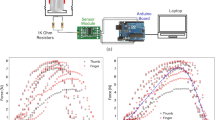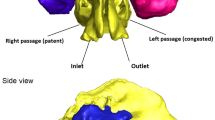Abstract
For various sinonasal conditions, including chronic rhinosinusitis, saline irrigation is an accepted standard-of-care treatment. This study was aimed at determining the effect of increased irrigation volumes and greater squeeze force on mucosal irrigation. A sinonasal cavity computational model was reconstructed from high-resolution CT scans of a healthy, unoperated 25-year old female. Seven combinations of irrigation volumes (70, 150, 200, and 400 mL) and squeeze forces (ramp time 0.1, 0.5, and 1.0 s) at a fixed head tilt of 0 degrees to the horizontal (Frankfort position) were performed. Velocity, pressure, and wall shear stress, together with mapping of surface coverage and residual volumes at specific locations and time were demonstrated. Higher volume irrigation (400 mL) and greater squeeze force (ramp time 0.1 s) improved irrigation coverage on the ipsilateral and contralateral sinonasal surfaces and increased shear force (approximately 140 Pa). An increase in irrigation volume from 70 to 150 mL approximately doubled sinus surface coverage and from 70 to 200 mL tripled sinus surface coverage. A faster squeeze also contributed to increased sinus surface coverage but its effect was less influential. We infer that the greater irrigation volume and squeeze force improve therapeutic benefit in terms of lavage and distribution of topical medications.

Similar content being viewed by others
Abbreviations
- α l,g :
-
volume fraction of liquid and gas
- κ :
-
surface curvature
- μ :
-
dynamic viscosity
- ∇:
-
gradient
- ∇·:
-
divergence
- ⊗:
-
outer product of two tensors
- ρ l,g :
-
density of liquid and gas
- σ :
-
surface tension coefficient
- \({\vec F}\) :
-
surface tension force
- \({\vec g}\) :
-
gravity
- HPC:
-
high performance computing
- p :
-
static pressure
- R 1,2 :
-
surface curvature as measured by two radii in orthogonal directions
- t :
-
time
- \({\vec v}\) :
-
velocity vector
- WSS:
-
wall shear stress
References
Alobid, I., Mullol, J. 2012. Role of medical therapy in the management of nasal polyps. Current Allergy and Asthma Reports, 12: 144–153.
Barham, H. P., Ramakrishnan, V. R., Knisely, A., Do, T. Q. P., Chan, L. S., Gunaratne, D. A., Weston, J. D., Seneviratne, S., Marcells, G. N., Sacks, R., Harvey, R. J. 2016. Frontal sinus surgery and sinus distribution of nasal irrigation. International Forum of Allergy & Rhinology, 6: 238–242.
Brackbill, J., Kothe, D., Zemach, C. 1992. A continuum method for modeling surface tension. Journal of Computational Physics, 100: 335–354.
Calmet, H., Inthavong, K., Eguzkitza, B., Lehmkuhl, O., Houzeaux, G., Vázquez, M. 2019. Nasal sprayed particle deposition in a human nasal cavity under different inhalation conditions. PLoS One, 14: e0221330.
Calmet, H., Inthavong, K., Owen, H., Dosimont, D., Lehmkuhl, O., Houzeaux, G., Vázquez, M. 2021. Computational modelling of nasal respiratory flow. Computer Methods in Biomechanics and Biomedical Engineering, 24: 440–458.
Campos, J., Heppt, W., Weber, R. 2013. Nasal douches for diseases of the nose and the paranasal sinuses—A comparative in vitro investigation. European Archives of Oto-Rhino-Laryngology, 270: 2891–2899.
Chen, P. G., Murphy, J., Alloju, L. M., Boase, S., Wormald, P. J. 2017. Sinus penetration of a pulsating device versus the classic squeeze bottle in cadavers undergoing sinus surgery. Annals of Otology, Rhinology & Laryngology, 126: 9–13.
Covello, V., Pipolo, C., Saibene, A., Felisati, G., Quadrio, M. 2018. Numerical simulation of thermal water delivery in the human nasal cavity. Computers in Biology and Medicine, 100: 62–73.
Craig, J. R., Palmer, J. N., Zhao, K. 2017. Computational fluid dynamic modeling of nose-to-ceiling head positioning for sphenoid sinus irrigation. International Forum of Allergy & Rhinology, 7: 474–479.
De Gabory, L., Kérimian, M., Baux, Y., Boisson, N., Bordenave, L. 2020. Computational fluid dynamics simulation to compare large volume irrigation and continuous spraying during nasal irrigation. International Forum of Allergy & Rhinology, 10: 41–48.
Even-Tzur, N., Kloog, Y., Wolf, M., Elad, D. 2008. Mucus secretion and cytoskeletal modifications in cultured nasal epithelial cells exposed to wall shear stresses. Biophysical Journal, 95: 2998–3008.
Farnoud, A., Baumann, I., Rashidi, M. M., Schmid, O., Gutheil, E. 2020a. Simulation of patient-specific bi-directional pulsating nasal aerosol dispersion and deposition with clockwise 45° and 90° nosepieces. Computers in Biology and Medicine, 123: 103816.
Farnoud, A., Tofighian, H., Baumann, I., Garcia, G. J. M., Schmid, O., Gutheil, E., Rashidi, M. M. 2020b. Large eddy simulations of airflow and particle deposition in pulsating bi-directional nasal drug delivery. Physics of Fluids, 32: 101905.
Farzal, Z., Basu, S., Burke, A., Fasanmade, O. O., Lopez, E. M., Bennett, W. D., Ebert, C. S. Jr., Zanation, A. M., Senior, B. A., Kimbell, J. S. 2019. Comparative study of simulated nebulized and spray particle deposition in chronic rhinosinusitis patients. International Forum of Allergy & Rhinology, 9: 746–758.
Frank-Ito, D. O., Kimbell, J. S., Borojeni, A. A. T., Garcia, G. J. M., Rhee, J. S. 2019. A hierarchical stepwise approach to evaluate nasal patency after virtual surgery for nasal airway obstruction. Clinical Biomechanics, 61: 172–180.
Frank-Ito, D. O., Wofford, M., Schroeter, J. D., Kimbell, J. S. 2016. Influence of mesh density on airflow and particle deposition in sinonasal airway modeling. Journal of Aerosol Medicine and Pulmonary Drug Delivery, 29: 46–56.
Grayson, J. W., Cavada, M., Wong, E., Lien, B., Duvnjak, M., Campbell, R., Kalish, L., Sacks, R., Harvey, R. J. 2019. Effects of sphenoid surgery on nasal irrigation delivery. International Forum of Allergy & Rhinology, 9: 971–976.
Grobler, A., Weitzel, E. K., Buele, A., Jardeleza, C., Cheong, Y. C., Field, J., Wormald, P. J. 2008. Pre- and postoperative sinus penetration of nasal irrigation. The Laryngoscope, 118: 2078–2081.
Hahn, I., Scherer, P. W., Mozell, M. M. 1993. Velocity profiles measured for airflow through a large-scale model of the human nasal cavity. Journal of Applied Physiology, 75: 2273–2287.
Harvey, R., Debnath, N., Srubiski, A., Bleier, B., Schlosser, R. J. 2009. Fluid residuals and drug exposure in nasal irrigation. Otolaryngology Head and Neck Surgery, 141: 757–761.
Head, K., Snidvongs, K., Glew, S., Scadding, G., Schilder, A.G., Philpott, C., Hopkins, C. 2018. Saline irrigation for allergic rhinitis. Cochrane Database of Systematic Reviews, 6: CD012597
Hinze, J. 1975. Turbulence. Mcgraw-Hill Publishing Co.
Hirt, C., Nichols, B. 1981. Volume of fluid (VOF) method for the dynamics of free boundaries. Journal of Computational Physics, 39: 201–225.
Inthavong, K. 2020. From indoor exposure to inhaled particle deposition: A multiphase journey of inhaled particles. Experimental and Computational Multiphase Flow, 2: 59–78.
Inthavong, K., Chetty, A., Shang, Y., Tu, J. 2018. Examining mesh independence for flow dynamics in the human nasal cavity. Computers in Biology and Medicine, 102: 40–50.
Inthavong, K., Shang, Y., Wong, E., Singh, N. 2020. Characterization of nasal irrigation flow from a squeeze bottle using computational fluid dynamics. International Forum of Allergy & Rhinology, 10: 29–40.
Lee, K. B., Jeon, Y. S., Chung, S. K., Kim, S. K. 2016. Effects of partial middle turbinectomy with varying resection volume and location on nasal functions and airflow characteristics by CFD. Computers in Biology and Medicine, 77: 214–221.
Massy-Westropp, N. M., Gill, T. K., Taylor, A. W., Bohannon, R. W., Hill, C. L. 2011. Hand Grip Strength: Age and gender stratified normative data in a population-based study. BMC Research Notes, 4: 127.
Menter, F. R. 1994. Two-equation eddy-viscosity turbulence models for engineering applications. AIAA Journal, 32: 1598–1605.
Olson, D. E. L., Rasgon, B. M., Hilsinger, R. L. Jr. 2002. Radiographic comparison of three methods for nasal saline irrigation. The Laryngoscope, 112: 1394–1398.
Papsin, B., McTavish, A. 2003. Saline nasal irrigation: Its role as an adjunct treatment. Canadian Family Physician, 49: 168–173.
Patki, A., Frank-Ito, D. O. 2016. Characterizing human nasal airflow physiologic variables by nasal index. Respiratory Physiology & Neurobiology, 232: 66–74.
Piromchai, P., Puvatanond, C., Kirtsreesakul, V., Chaiyasate, S., Suwanwech, T. 2020. A multicenter survey on the effectiveness of nasal irrigation devices in rhinosinusitis patients. Laryngoscope Investigative Otolaryngology, 5: 1003–1010.
Pynnonen, M. A., Mukerji, S. S., Kim, H. M., Adams, M. E., Terrell, J. E. 2007. Nasal saline for chronic sinonasal symptoms. Archives of Otolaryngology-Head & Neck Surgery, 133: 1115.
Salati, H., Bartley, J., White, D. E. 2020. Nasal saline irrigation — A review of current anatomical, clinical and computational modelling approaches. Respiratory Physiology & Neurobiology, 273: 103320.
Salib, R. J., Talpallikar, S., Uppal, S., Nair, S. B. 2013. A prospective randomised single-blinded clinical trial comparing the efficacy and tolerability of the nasal douching products Sterimar™ and Sinus Rinse™ following functional endoscopic sinus surgery. Clinical Otolaryngology, 38: 297–305.
Shrestha, K., Salati, H., Fletcher, D., Singh, N., Inthavong, K. 2021. Effects of head tilt on squeeze-bottle nasal irrigation — A computational fluid dynamics study. Journal of Biomechanics, 123: 110490.
Singhal, D., Weitzel, E. K., Lin, E., Feldt, B., Kriete, B., McMains, K. C., Thwin, M., Wormald, P. J. 2010. Effect of head position and surgical dissection on sinus irrigant penetration in cadavers. The Laryngoscope, 120: 2528–2531.
Snidvongs, K., Kalish, L., Sacks, R., Sivasubramaniam, R., Cope, D., Harvey, R. J. 2013. Sinus surgery and delivery method influence the effectiveness of topical corticosteroids for chronic rhinosinusitis: Systematic review and meta-analysis. American Journal of Rhinology & Allergy, 27: 221–233.
Snidvongs, K., Thanaviratananich, S. 2017. Update on intranasal medications in rhinosinusitis. Current Allergy And Asthma Reports, 17: 47.
Succar, E. F., Turner, J. H., Chandra, R. K. 2019. Nasal saline irrigation: A clinical update. International Forum of Allergy & Rhinology, 9: S4–S8.
Tong, X., Dong, J., Shang, Y., Inthavong, K., Tu, J. 2016. Effects of nasal drug delivery device and its orientation on sprayed particle deposition in a realistic human nasal cavity. Computers in Biology and Medicine, 77: 40–48.
Van Strien, J., Shrestha, K., Gabriel, S., Lappas, P., Fletcher, D. F., Singh, N., Inthavong, K. 2021. Pressure distribution and flow dynamics in a nasal airway using a scale resolving simulation. Physics of Fluids, 33: 011907.
Wong, E., Sansoni, E. R., Do, T. Q. P., Matchett, I., Kalish, L. H., Sacks, R., Harvey, R. J. 2020. Cadaveric assessment of the efficacy of sinus irrigation after staged clearance of the medial maxillary wall. American Journal of Rhinology & Allergy, 34: 290–296.
Wormald, P. J., Cain, T., Oates, L., Hawke, L., Wong, I. 2004. A comparative study of three methods of nasal irrigation. The Laryngoscope, 114: 2224–2227.
Xi, J., Wang, Z., Si, X. A., Zhou, Y. 2018. Nasal dilation effects on olfactory deposition in unilateral and bi-directional deliveries: In vitro tests and numerical modeling. European Journal of Pharmaceutical Sciences, 118: 113–123.
Zhang, Y., Shang, Y., Inthavong, K., Tong, Z., Sun, B., Zhu, K., Yu, A., Zheng, G. 2019. Computational investigation of dust mite allergens in a realistic human nasal cavity. Inhalation Toxicology, 31: 224–235.
Zhao, K., Craig, J. R., Cohen, N. A., Adappa, N. D., Khalili, S., Palmer, J. N. 2016. Sinus irrigations before and after surgery-Visualization through computational fluid dynamics simulations. The Laryngoscope, 126: E90–E96.
Acknowledgements
We gratefully acknowledge the financial support provided by Garnett Passe and Rodney Williams Memorial Foundation Conjoint Grant 2019. Kiao Inthavong is a consultant for ENT Technologies and received a research grant for part of this current work.
Author information
Authors and Affiliations
Corresponding author
Ethics declarations
The authors have no competing interests to declare that are relevant to the content of this article.
Rights and permissions
About this article
Cite this article
Shrestha, K., Wong, E., Salati, H. et al. Liquid volume and squeeze force effects on nasal irrigation using Volume of Fluid modelling. Exp. Comput. Multiph. Flow 4, 445–464 (2022). https://doi.org/10.1007/s42757-021-0123-5
Received:
Revised:
Accepted:
Published:
Issue Date:
DOI: https://doi.org/10.1007/s42757-021-0123-5




